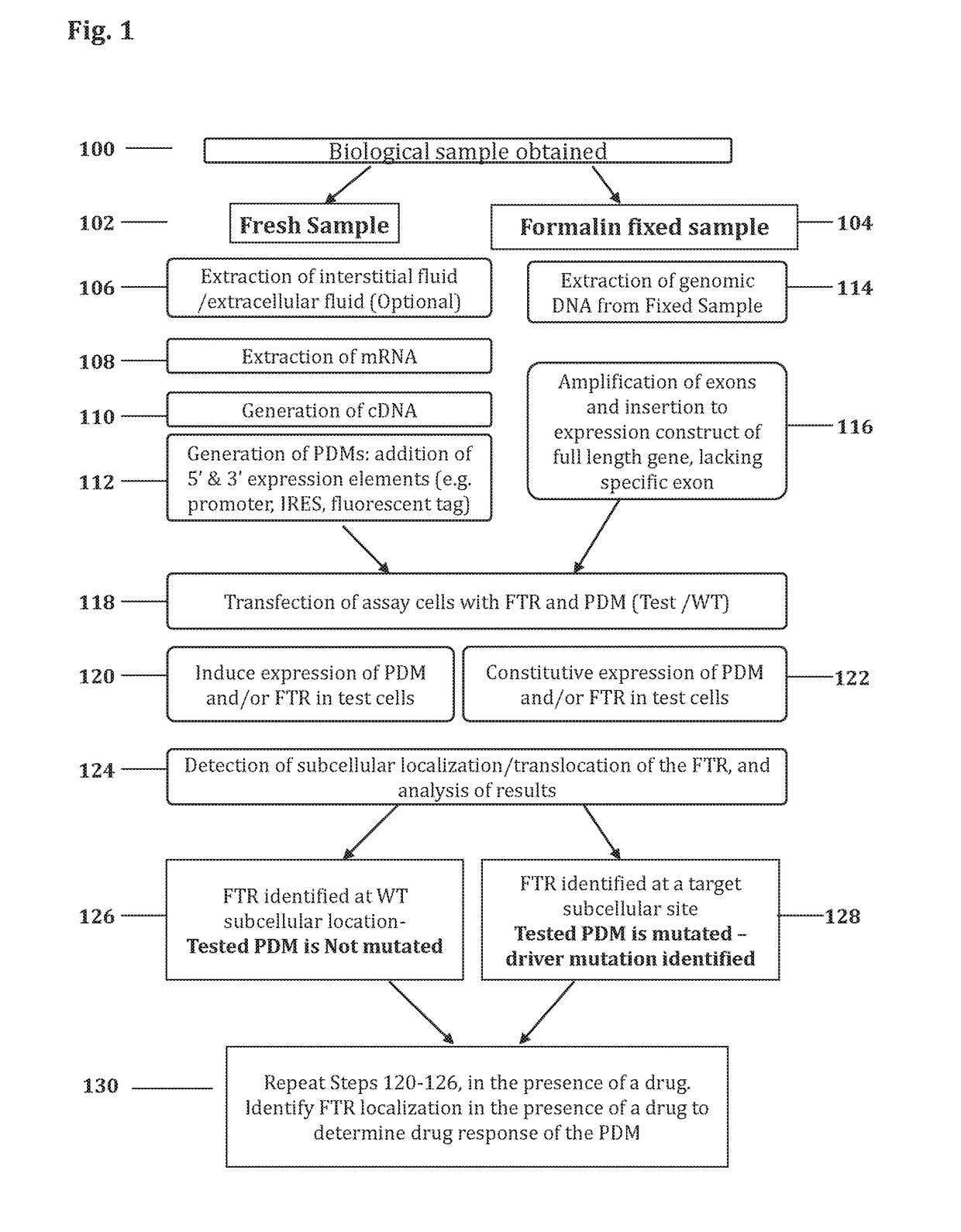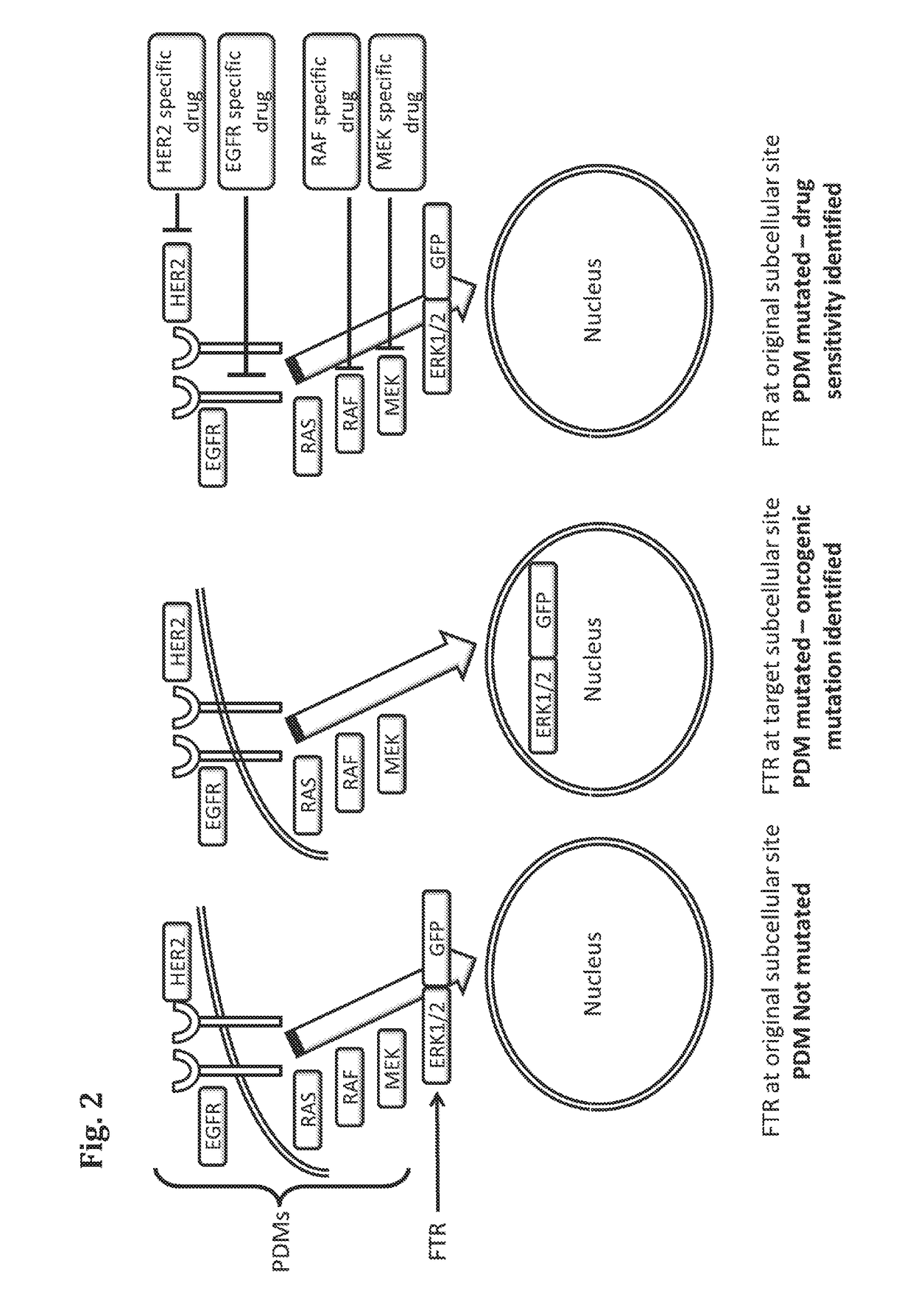Methods for determining drug response of patient specific mutations
a technology of specific mutations and drug responses, applied in the direction of drug compositions, biochemistry apparatus and processes, anti-antineoplastic agents, etc., can solve the problem of limited suitability of whole-genome sequencing (next-generation sequencing) for targeting therapy selection, and achieve the effect of determining the response (or susceptibility)
- Summary
- Abstract
- Description
- Claims
- Application Information
AI Technical Summary
Benefits of technology
Problems solved by technology
Method used
Image
Examples
example 1
Patient BRAF Mutation Confers Resistance to the ERBB2 Inhibitor Neratinib
[0331]A 66 year old male was diagnosed with metastatic lung adenocarcinoma. The patient was treated with Herceptin and subsequently with Neratinib which did not provide progression free survival (PFS) and progressive disease maintained. Patient passed away after 2 months of therapy. In addition to an ERBB2 / HER2 oncogenic mutation (A771_Y772insYVMA, G776C) and AKT1 amplification, a BRAF I554T mutation was identified, and was shown to be highly oncogenic using the methods disclosed herein. A needle biopsy from a liver metastatic site was used as a biological sample.
Hela assay cells were transfected with a WT BRAF or a patient mutated BRAF, along with the corresponding FTR, ERK2 GFP. Cells were left untreated or treated with the ERBB2 inhibitor Neratinib at a concentration of 600 nM, for 6 hours. 30 hours after transfection, cells were fixed and imaged utilizing a fluorescence microscope. The amount of the FTR in ...
example 2
Patient BRAF Mutation Confers Resistance to the ERBB2 Inhibitor Neratinib
[0332]As in Example 1, Hela assay cells were transfected with a WT BRAF or a patient mutated BRAF (I554T), along with the corresponding FTR, ERK2 GFP. Cells were left untreated or treated with the BRAF inhibitor Regorafenib at a concentration of 1 μM, for 24 hours. 30 hours after transfection, cells were fixed and imaged utilizing a fluorescence microscope. The amount of the FTR in the cytoplasm and in the nucleus was quantified. The ratio between the intensity of the FTR in the nucleus (N) and cytoplasm (C) was measured (N:C ratio). The results are presented in FIGS. 4A-B, which show that higher N:C of ERK is observed when the mutated patient gene is transfected into the cells, as compared to the WT gene. As further shown in FIG. 4A, when measuring the response of the patient mutant to a direct inhibitor, Regorafenib, the oncogenic activity of the mutant was abolished and reverted back to levels lower than tho...
example 3
Patient EGFR Mutation is Resistant to Erlotinib but Sensitive to Afatinib
[0333]A 34 year old female was diagnosed with stage IV lung adenocarcinoma. The patient was treated with Erlotinib together with chemotherapy and responded well. After 12 months developed resistance to treatment. This was followed by Afatinib treatment, with good response. This response was short (4 months), and after progression there was no response for either Cetuximab to Afatinib. Once resistance appeared, the following mutations were identified by sequencing (NGS) in several genes: MUTYH (p.V376L; .V390L; p.V362L; .V363L; p.V387L); EGFR (p.G719A); EGFR (p.T790M); EGFR (p.L861Q); TRIM24 (p.C595S; p.C629S); BRD3 (p.G677W); NOTCH1 (p.C222fs); BIVM-ERCC5; ERCC5 (p.M254V; p.M708V).
[0334]Previous experiments using the methods disclosed herein, identified the patient's EGFR mutation as highly oncogenic, affecting multiple pathways. The triple mutation in EGFR consists of 2 known oncogenic mutations—G719A and L861...
PUM
| Property | Measurement | Unit |
|---|---|---|
| Concentration | aaaaa | aaaaa |
| Fluorescence | aaaaa | aaaaa |
Abstract
Description
Claims
Application Information
 Login to View More
Login to View More - R&D
- Intellectual Property
- Life Sciences
- Materials
- Tech Scout
- Unparalleled Data Quality
- Higher Quality Content
- 60% Fewer Hallucinations
Browse by: Latest US Patents, China's latest patents, Technical Efficacy Thesaurus, Application Domain, Technology Topic, Popular Technical Reports.
© 2025 PatSnap. All rights reserved.Legal|Privacy policy|Modern Slavery Act Transparency Statement|Sitemap|About US| Contact US: help@patsnap.com



